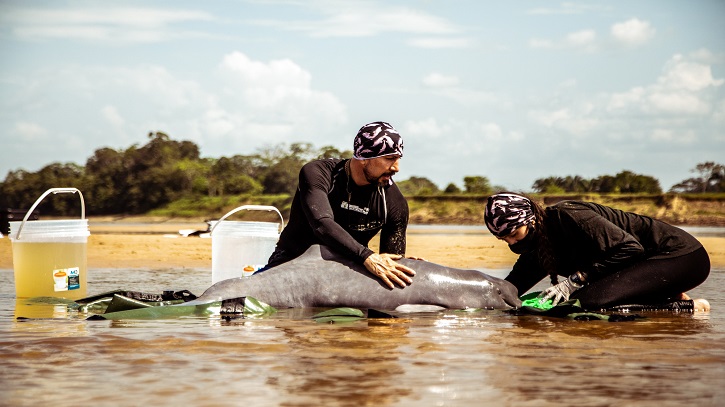
A team of paleontologists found a giant fossilized skull along the shore of the Napo River in the Peruvian Amazon. To their surprise, the relic belonged to a newly described species of giant freshwater dolphin.
This colossal creature swam in the rivers of the Amazon around 16 million years ago and is considered the largest-known species of river dolphin to have ever lived, measuring 3-3.5 meters (9.8-11.5 feet).
“As soon as I recognized it, I saw the teeth sockets. I screamed, ‘this is a dolphin.’ We could not believe it,” Aldo Benites-Palomino told The Guardian.
Scientists unearthed the fossil during a 2018 expedition led by the University of Zurich (UZH). The new species has been named Pebanista yacuruna, after mythical aquatic beings (Yacuruna) believed by some Indigenous groups to live deep in the river.
The team was also surprised to find that the ancient creature was not related to the local, living species of Amazon river pink dolphin (Inia geoffrensis) but rather to South Asian river dolphins (genus Platanista).
“We [had] found an animal, a giant, whose closest living relative is 10,000km away in south-east Asia,” Benites-Palomino was quoted as saying.
The newly discovered dolphin species and its relative in South Asia share highly developed bony structures called facial crests, which they use for echolocation.
“For river dolphins, echolocation, or biosonar, is even more critical as the waters they inhabit are extremely muddy, which impedes their vision,” Gabriel Aguirre-Fernández, a UZH researcher and co-author of the study, said in a statement.
The researchers say they believe the giant dolphin’s ancestors originally lived in the ocean and ventured into the bountiful freshwater ecosystems of proto-Amazonia, adapting to their new environment. However, as the landscape shifted and new habitats emerged, Pebanista‘s prey vanished, ultimately leading to its extinction.
This finding comes at a time when the six existing species of modern river dolphins face unprecedented threats. The combined populations of river dolphin species have decreased by 73% since the 1980s due to unsustainable fishing practices, climate change, pollution, illegal mining, dams and dredging.
In September 2023, more than 125 river dolphins were found dead in Brazil’s Lake Tefé. Experts suspect climate change’s devastating impacts, with soaring temperatures and plummeting water levels, create hostile conditions for these aquatic mammals.
“For us, this is a crisis. In one month, more than 10% of the populations of the two dolphin species that inhabit Lake Tefé died. We’ve never seen this before. It’s climate change,” Daphne Willems, WWF’s global leader of river dolphin research, said in an interview with Mongabay earlier this year.
The six species of river dolphins are the Amazon pink river dolphin, the Ganges river dolphin (P. gangetica), the Indus river dolphin (P. minor), the Irrawaddy dolphin (Orcaella brevirostris), the tucuxi (Sotalia fluviatilis) and the Indo-Pacific finless porpoise (Neophocaena phocaenoides), which is the only freshwater porpoise on the planet.
A seventh river dolphin endemic to the Yangtze River in China, the baiji (Lipotes vexillifer), was declared likely extinct in 2007. This is the first dolphin species pushed to extinction by humans in modern times.
However, amid the crisis, conservation efforts are underway. Thanks to rigorous protection measures, the critically endangered Yangtze finless porpoise in China has seen a 23% population increase over the past five years.
In Indonesia, innovative signaling devices have proved effective in preventing dolphin entanglement in fishing nets while boosting fish catches for local communities.
Researchers have combined advanced acoustic monitoring and AI to study the habits of endangered pink river dolphins in seasonally flooded habitats of the Amazon to aid conservation.
In many of the world’s largest river systems, dolphins are top predators and play a critical role in balancing the ecosystem. They are also indicators of the rivers’ health. If the dolphins are thriving, the fish populations they depend on for food are likely also doing well.
This year, nine countries signed the Global Declaration for River Dolphins, a united effort to safeguard these aquatic mammals and emphasize the urgent need for action. “The crisis facing river dolphin populations has not yet reached the international attention it deserves,” the declaration states. “Saving these species is a mutual responsibility that also benefits rivers and wetlands.”





